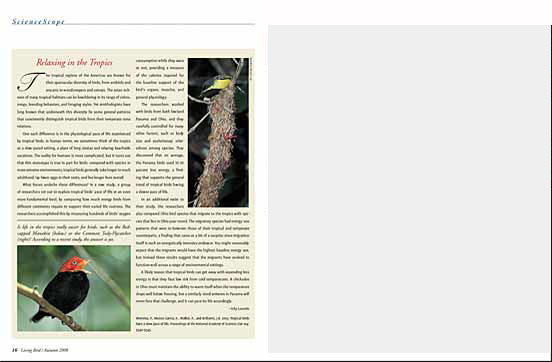Relaxing in the Tropics—the Pace of Life for Birds
By Irby Lovette October 15, 2008
The tropical regions of the Americas are known for their spectacular diversity of birds, from antbirds and aracaris to woodcreepers and xenops. The avian richness of many tropical habitats can be bewildering in its range of colors, songs, breeding behaviors, and foraging styles. Yet ornithologists have long known that underneath this diversity lie some general patterns that consistently distinguish tropical birds from their temperate-zone relatives.
One such difference is in the physiological pace of life experienced by tropical birds. In human terms, we sometimes think of the tropics as a slow-paced setting, a place of long siestas and relaxing beachside vacations. The reality for humans is more complicated, but it turns out that this stereotype is true in part for birds: compared with species in more extreme environments, tropical birds generally take longer to reach adulthood, lay fewer eggs in their nests, and live longer lives overall.
What forces underlie these differences? In a new study, a group of researchers set out to explore tropical birds’ pace of life at an even more fundamental level, by comparing how much energy birds from different continents require to support their varied life routines. The researchers accomplished this by measuring hundreds of birds’ oxygen consumption while they were at rest, providing a measure of the calories required for the baseline support of the bird’s organs, muscles, and general physiology.
The researchers worked with birds from both lowland Panama and Ohio, and they carefully controlled for many other factors, such as body size and evolutionary relatedness among species. They discovered that on average, the Panama birds used 10-20 percent less energy, a finding that supports the general trend of tropical birds having a slower pace of life.
In an additional twist to their study, the researchers also compared Ohio bird species that migrate to the tropics with species that live in Ohio year-round. The migratory species had energy-use patterns that were in-between those of their tropical and temperate counterparts, a finding that came as a bit of a surprise since migration itself is such an energetically intensive endeavor. You might reasonably expect that the migrants would have the highest baseline energy use, but instead these results suggest that the migrants have evolved to function well across a range of environmental settings.
A likely reason that tropical birds can get away with expending less energy is that they face low risk from cold temperatures. A chickadee in Ohio must maintain the ability to warm itself when the temperature drops well below freezing, but a similarly sized antwren in Panama will never face that challenge, and it can pace its life accordingly.
Wiersma, P., Munoz-Garcia, A., Walker, A., and Williams, J.B. 2007. Tropical birds have a slow pace of life. Proceedings of the National Academy of Sciences USA 104: 9340-9345.

All About Birds
is a free resource
Available for everyone,
funded by donors like you
American Kestrel by Blair Dudeck / Macaulay Library



